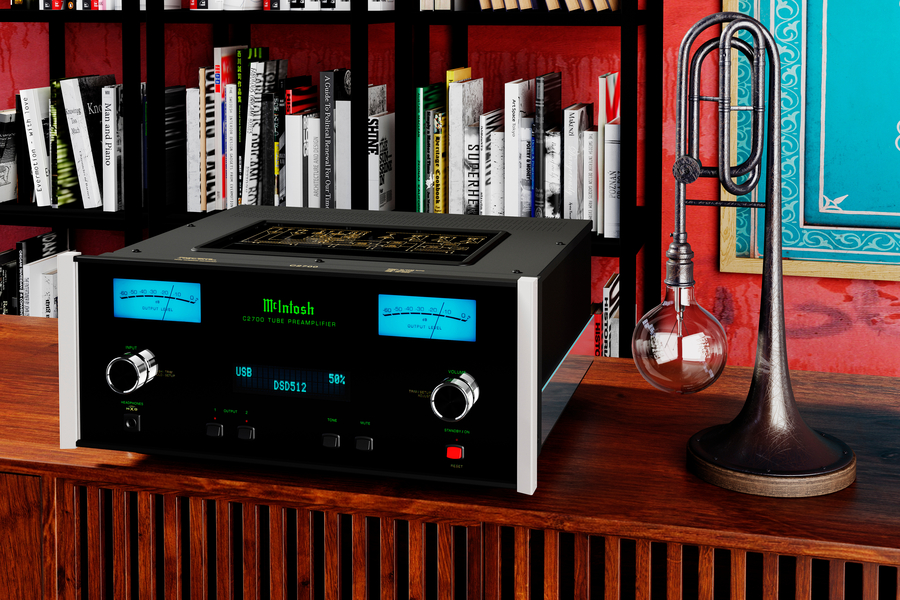Premium Sound Systems: Separates vs. Integrated Solutions
What’s the Right Approach for You?

It's one of those debates that never gets old in audio circles: do separate components automatically deliver better sound than a high-quality integrated amplifier? Walk into any hi-fi forum, and you'll find passionate advocates on both sides. Some swear that premium sound systems demand the ultimate flexibility of separates, while others argue that today's integrated amplifiers have closed the performance gap entirely.
The truth is more nuanced than either camp wants to admit. After nearly five decades helping Boston area residents build exceptional audio systems, we've had plenty of opportunities to compare these approaches directly. Let's delve into what really matters when choosing between integrated and separate components.
SEE ALSO: Floorstanding vs. Bookshelf Speakers: The Real Differences Beyond Size
McIntosh MA352: Integrated Excellence
The integrated amplifier has come a long way from its budget-friendly origins. Take the McIntosh MA352—this isn't a compromise solution of any kind. With 200 watts per channel into 8 ohms (320 into 4 ohms), it delivers serious power wrapped in McIntosh's signature hybrid tube/solid-state design. The tube preamp section provides the warmth and musicality McIntosh is known for, while the solid-state power section handles demanding speakers with ease.
The practical benefits are undeniable—one box, one power cord, one remote control. The internal connections are optimized and shielded from interference. There's no cable matching to worry about, no placement challenges, and significantly less rack space required. For many listeners, especially those building their first serious system, the MA352 removes variables and delivers exceptional sound right out of the box.
McIntosh Separates: C2800 Preamp + MC312 Amplifier
Let's look at a couple of McIntosh separates that are a close match to the MA352 integrated. The C2800 tube preamp paired with the MC312 solid-state power amplifier (300 watts into 8 ohms) creates a system that's remarkably close in power and character to the MA352, but with fundamental differences in flexibility.
Each component can be optimized for its specific job. The C2800 focuses entirely on signal processing and gain, while the MC312 dedicates itself to power delivery. Separate power supplies mean less interaction between delicate preamp circuits and high-current amplification. You can position components optimally—maybe the preamp near your listening position for easy access, while the power amp sits closer to the speakers for shorter speaker cables - but not too far away.
But optimizing for performance with separates does have drawbacks: more boxes mean more cables, more potential connection points for problems, and significantly more complexity. You'll need quality interconnects, proper rack space, and careful attention to component placement and cooling. Not to mention that separates will cost more.
Beyond Specifications: What Actually Matters
The performance difference between our MA352 and C2800/MC312 combination is surprisingly subtle. Both deliver that distinctive McIntosh sound signature, and both have plenty of power for most speakers. The real differentiators emerge in practical considerations.
Room size plays a bigger role than most people expect. In smaller Boston-area listening rooms, the integrated's compact footprint and simplified setup often make more sense. But if you're setting up a dedicated listening room in a Wellesley colonial or Newton Tudor, separates give you placement flexibility that can optimize both sound and aesthetics.
Future expansion plans matter enormously. Planning to add more demanding speakers or some new digital format down the road? Separates let you upgrade incrementally—swap the power amp while keeping the preamp, or vice versa. The integrated locks you into one upgrade path: replace the entire unit.
Budget considerations aren't always straightforward either. While separates cost more initially, they might be more economical long-term if you're the type who upgrades regularly.
Your System, Your Way
Choose the integrated approach if you value simplicity, have space constraints, or want to minimize variables in your first premium system. Go with separates if you're planning a dedicated listening room, anticipate future upgrades, or simply enjoy the flexibility of building a system component by component. Both paths lead to exceptional music reproduction. The question isn't which sounds better—it's which approach fits how you want to experience and evolve your system over time.
Ready to hear the difference for yourself? Visit our showroom to compare both approaches with your favorite music. At Natural Sound, we've been helping audiophiles throughout Boston and Massachusetts build their dream systems since 1975. Contact us to schedule your listening session.

